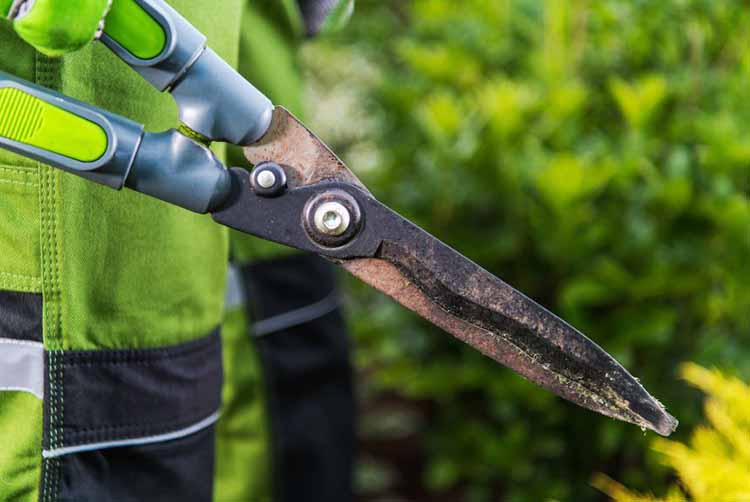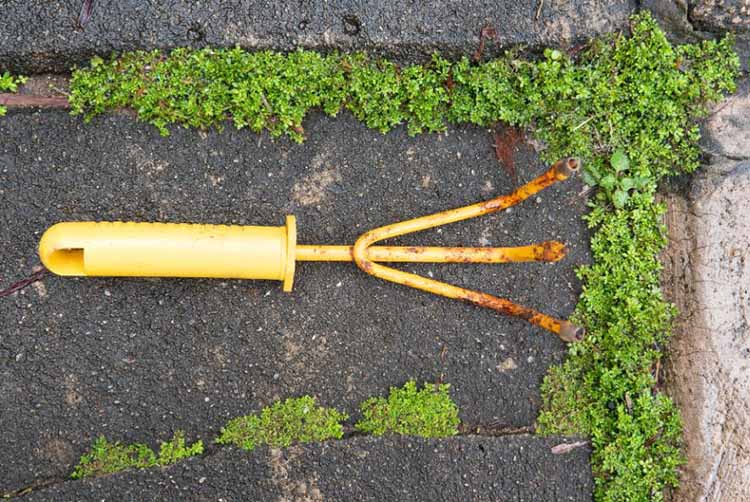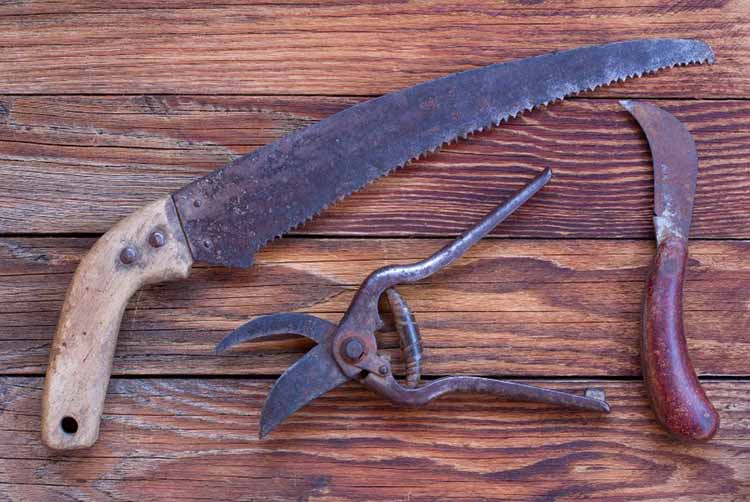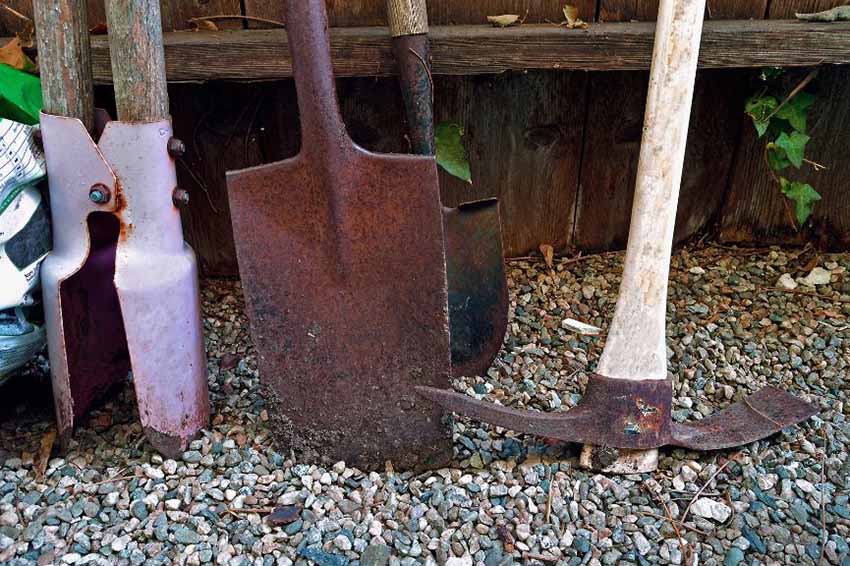If you are the owner of a home garden then must have some tools used for gardening. On regular use the garden hand tools get rusty. The best way to clean rusty garden tools will keep you worry-free over the year of the gardening hobby. This process also includes rusty garden tools cleaning procedure. We are not showing clean rusty garden tools using vinegar but it’s an effective way of quick way to clean garden tools.
Don’t let laziness result in rusty blades and sticky pruners. Apply this to clean rusty garden tools rapidly and sharpen them routinely by organizing easy tools stations in your yard. All you require are a bucket of sand and a bottle of oil.
If it appears like your gardening hand tools have seen greater days, don’t be embarrassed -soiled garden tools are an indication of laborious work and plentiful rewards.
But they shouldn’t be put away from dirt. By following these tips for the best way to clean rusty garden tools, all of your tools used for gardening will be like new and long-lasting with high performance.
I do know, I understand who wishes to scrub garden tools every single time if all you’re doing is snipping a couple of stems right here and there.
Believe me, after I say I’m one of many laziest gardeners there are. I let weeds get unruly and my end-of-season backyard clean-up is normally a couple of weeks too late. But the one factor I all the time keep on prime of is preserving my garden hand tools clear and sharp — and it takes only a few minutes.
The way is making a DIY best way to clean rusty garden tools station that keeps the chore out of sustaining your tools used for gardening. It’s fast and easy to arrange this for the first time, and only as fast and easy to scrub your garden hand tools once you get it started.
This process to clean rusty garden tools station not solely retains your garden tools grime-free and rust-free, it sharpens them gently (and routinely, with no additional effort in your half) so you’ll be able to dig, cut, trim, and prune your vegetation safely and successfully.
The Best Way to Clean Rusty Garden Tools
You may not have to comply with each step each time, however, you’ll need to sort out problems such as sap along with rust earlier than they develop into greater issues down the way. You will find your own easy way of how to clean rusty garden tools?

The Quickest Way for Best way to clean rusty garden tools
Gather all the tools used for gardening in a bin and then place it subsequent to your “quick clean” pot in a shaded spot close to your backyard (just similar to a shed, storage, mudroom, or closed walkway).
The secret is maintaining them the place they’re advantageous to hold in your manner out to the garden, and easier to place away as you’re going back to the backward in the home.
It’s only too simple to fall within the nature of dumping your garden tools in scattered locations (thereby not placing them right or you forget to scrub them), or storing the tools wherever you will have room. This may imply an out-of-the-way nook in your garden or a stand (shelf) that needs a stepladder to get in touch.
For the period of the gardening season, not less, clear a little area on your best way to clean rusty garden tools place and keep it simply accessible if you’re working outdoors. (For my case is only in opposition to the wall of a closed garden tool storage space.)
What is the Things Need for Best Way to Clean Rusty Garden Tools Bin?
- A little storage bin, crate, or pail
- Putty metal scraper or plastic scraper
- Shop towels or rags
- 3-IN-ONE® Multi-Purpose Oil
- Steel wool
- Boiled linseed oil, original tung oil, or teak oil
- 70% isopropyl alcohol (rubbing alcohol)
What you’ll Require for the “Quick Way To Clean Rusty Garden Tools” Bucket
-Sturdy bucket (no less than 8 inches deep and 12 inches throughout, depending on what number of garden hand tools you will have)
-5-gallon bucket (non-obligatory, for the big Best way to clean rusty garden tools station)
-Sand (Check note below)
Note: The sand you utilize might be as fine (small size) as all-purpose play sand, or as coarse as washed plaster sand. Just ensure you use clear sand from a house construction site or landscaping firm.

Step 1: Any Caked Dirt to Be Removed
Scrape off any firm, caked-on dust with a putty knife, then wash off any remaining dust with a sharp edge blast of water from a backyard hose.
Dry your garden hand tools completely with a towel. (Don’t allow them to air dry, as they may begin to rust earlier than all of the moisture evaporates.)
Step 2: Remove any Liquid Dirt.
If your gardening shears or clippers seem sticky, they may have sap, resin, or insect residue.
Apply a couple of drops of Multi-Purpose Oil to the sticky spots and wipe with a clean cloth. Pay particular attention to hinged areas and pivot joints that are likely to get gummed up.
Step 3: Penetrate Rusty Area.
If you see rust or pitting in your gardening hand tools — particularly if it’s inflicting shifting elements to stick — squirt a couple of drops of Multi-Purpose Oil on these areas and provide a great scrub with metal wool. Wipe off the residue with a rag and repeat as required
Step 4: Pour Oil on Wood Handles.
Unpainted wood handles dry out simply, particularly in case your garden hand tools have been sitting outdoors all season.
Saturate a rag with boiled linseed oil and rub it a couple of instances over your wood handles. Allow the oil to penetrate for about 10 minutes, and then buff the handles briskly with a clean cloth till they completely feel dry.
If the handles are additionally dry (maybe from baking in the sunlight a previous couple of summers), they could require fairly a little bit of oil. Let the wooden handle absorb the oil the whole night, then apply additional oil as required the following day.
Safety Note:
Place the oily rag on a flat place for air drying in between each use. (You also can cling it up close to your garden hand tools to remember your self to apply oil on the handles on regular basis.) Never gather oily rags collectively or dump them in the trash when moist. Oil-soaked rags provide heat along with the drying and might ignite their very own, particularly on a scorching day.
Step 5: Disinfecting the Blades along with Tines.
Pruners as well as other garden hand tools that had been used on unhealthy plants must be disinfected therefore that they don’t transmit fungi and micro organisms to healthy plants.
You can cautiously sterilize your garden hand tools with polishing alcohol, and personally, I prefer to maintain mine in a spray bottle for easiness of use.
Carefully give all sides of the blades spray, tines, hinges, and pivot joints, and finally clean off them down. Or, dab a small quantity of polishing alcohol onto a clean cloth to purify your garden hand tools whenever you finish using them.
Step 6: Store Garden Hand Tools in a “Completely Clean” Bucket.
To arrange your “quick clean” bucket, fill a bucket about three-quarters full with sand. Mix in simply sufficient Multi-Purpose Oil to attain a damp (but not too wet) consistency — just like a wrung-out sponge.
After a day in the backyard, deposit your garden hand tools within the “quick clean” bucket to guard their end and keep them free from rust.
You also can make a second “quick clean” bucket (utilizing a deeper 5-gallon bucket) to scrub and sharpen shovels, spades, and backyard hoes earlier than storing them in your shed or storage. Having this thin coat of oil in your garden hand tools protects them from corrosion, particularly if you reside in damp or foggy local weather.
Summary
Hope the above article has taught you how to care for garden tools? Though it’s easy but if you do not know how to take care of garden tools, then you will be stuck after few months with the performance of the tools used for gardening.
If you regularly apply the knowledge of how to maintain garden tools then your garden hand tools will be useful always. So keep your garden tool clean and be happy.
Frequently Asked Questions for Best Way To Clean Rusty Garden Tools
I can just discover linseed oil within the retailer, not boiled linseed oil. Can I utilize that as an alternative for oiling my wood handles?
Both kinds of linseed oil will work, however boiled linseed oil dries quicker (in two or three days, versus two weeks for unfiltered linseed oil).
If you’re performed along with your tools for the season, go forward and use whichever kind of linseed oil is available. In a pinch, you too can use flaxseed oil (from the grocery store), which is just food-grade linseed oil.

Can you employ olive oil to grease picket handles?
I don’t advocate utilizing olive oil or vegetable oil to deal with your backyard software handles. Non-drying oils like these can flip sticky or rancid over time.
Can you utilize olive oil to grease wood handles?
I don’t suggest utilizing olive oil or vegetable oil to deal with your garden hand tool handles. Non-drying oils like these can flip sticky or rancid over time.
Can you utilize disinfectant wipes to sanitize your gardening hand tools?
Household disinfectant wipes (like Lysol or Clorox) can be utilized to sanitize garden hand tools, however, their effectiveness in opposition to plant pathogens hasn’t been scientifically decided.
They’re additionally a bit of costlier than rubbing alcohol (my first selection for backyard disinfection) and after opening, the wipes are inclined to dry out in the event that they aren’t used regularly.
My gardening hand tools are all stainless-steel. Do I right now require providing oil to them?
Stainless metal doesn’t essentially indicate freed from stains — it commonly means the metallic stains lower than carbon or alloy steels. And sure grades of stainless-steel are more susceptible to corrosion than others, so your stainless-steel garden hand tool may begin to rust if not correctly cared for.
Applying a skinny layer of oil like 3-IN-ONE Multi-Purpose Oil to all of your garden hand tools (together with stainless-steel garden tools) is a simple confirmation of coverage towards rusting (and plenty of elbow grease next time).
